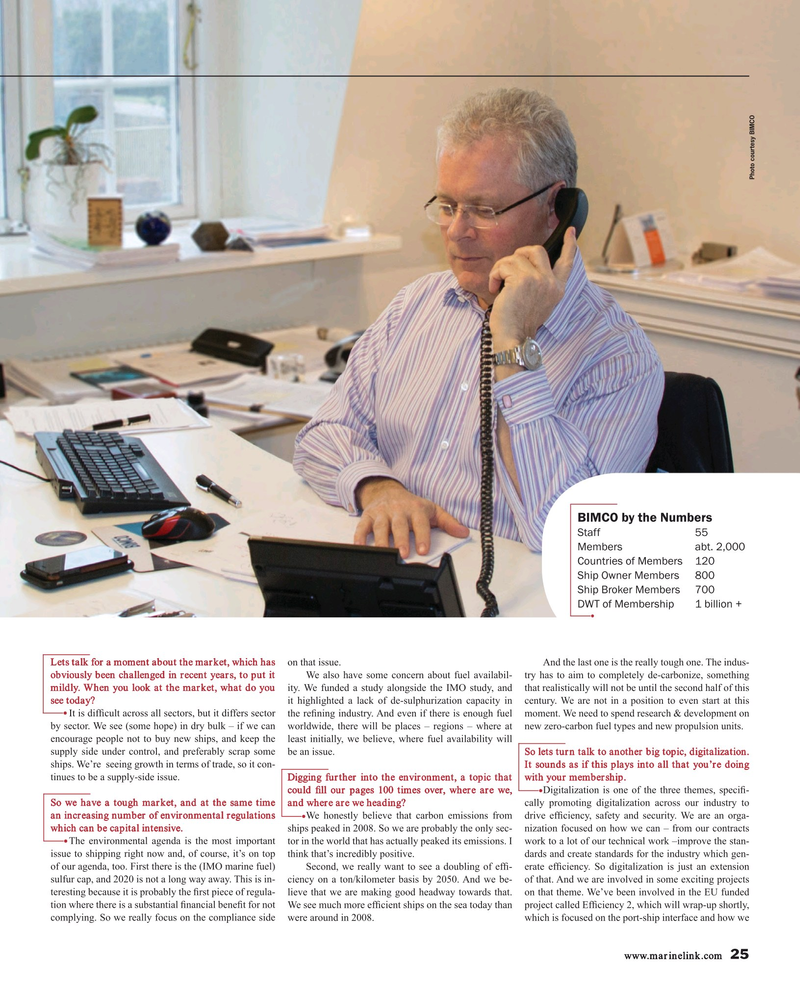
Page 25: of Maritime Reporter Magazine (March 2018)
Annual World Yearbook
Read this page in Pdf, Flash or Html5 edition of March 2018 Maritime Reporter Magazine
Photo courtesy BIMCO
BIMCO by the Numbers
Staff 55
Members abt. 2,000
Countries of Members 120
Ship Owner Members 800
Ship Broker Members 700
DWT of Membership 1 billion +
Lets talk for a moment about the market, which has on that issue. And the last one is the really tough one. The indus- obviously been challenged in recent years, to put it We also have some concern about fuel availabil- try has to aim to completely de-carbonize, something mildly. When you look at the market, what do you ity. We funded a study alongside the IMO study, and that realistically will not be until the second half of this see today? it highlighted a lack of de-sulphurization capacity in century. We are not in a position to even start at this It is dif? cult across all sectors, but it differs sector the re? ning industry. And even if there is enough fuel moment. We need to spend research & development on by sector. We see (some hope) in dry bulk – if we can worldwide, there will be places – regions – where at new zero-carbon fuel types and new propulsion units. encourage people not to buy new ships, and keep the least initially, we believe, where fuel availability will supply side under control, and preferably scrap some be an issue. So lets turn talk to another big topic, digitalization. ships. We’re seeing growth in terms of trade, so it con- It sounds as if this plays into all that you’re doing tinues to be a supply-side issue. Digging further into the environment, a topic that with your membership.
could ? ll our pages 100 times over, where are we, Digitalization is one of the three themes, speci? -
So we have a tough market, and at the same time and where are we heading? cally promoting digitalization across our industry to an increasing number of environmental regulations We honestly believe that carbon emissions from drive ef? ciency, safety and security. We are an orga- which can be capital intensive. ships peaked in 2008. So we are probably the only sec- nization focused on how we can – from our contracts The environmental agenda is the most important tor in the world that has actually peaked its emissions. I work to a lot of our technical work –improve the stan- issue to shipping right now and, of course, it’s on top think that’s incredibly positive. dards and create standards for the industry which gen- of our agenda, too. First there is the (IMO marine fuel) Second, we really want to see a doubling of ef? - erate ef? ciency. So digitalization is just an extension sulfur cap, and 2020 is not a long way away. This is in- ciency on a ton/kilometer basis by 2050. And we be- of that. And we are involved in some exciting projects teresting because it is probably the ? rst piece of regula- lieve that we are making good headway towards that. on that theme. We’ve been involved in the EU funded tion where there is a substantial ? nancial bene? t for not We see much more ef? cient ships on the sea today than project called Ef? ciency 2, which will wrap-up shortly, complying. So we really focus on the compliance side were around in 2008. which is focused on the port-ship interface and how we www.marinelink.com 25
MR #3 (18-25).indd 25 MR #3 (18-25).indd 25 3/9/2018 3:36:19 PM3/9/2018 3:36:19 PM

 24
24

 26
26
